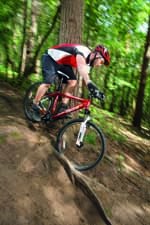 FRAME
FRAME
Both the top and down tube on the Aspire 2.0 have tall profiles where they meet the head tube to try to counter the twisting forces incurred when riding over technical terrain, preventing the front of the bike from pointing in a different direction to the rear. Towards the rear, the top tube stays circular, but the down tube changes to a much wider profile where it connects to the bottom bracket. This helps to resist pedal-induced twisting loads.
The rest of the frame is pretty standard stuff, with slightly ovalised chainstays helping to increase stiffness out back. Dropouts come with disc mounts and the forks include a post mount for a disc-brake caliper. One area of note, though, is the finish. Welding was neat and the Mercury Red paint looked great, making this a fast bike (because red’s always quicker, right?)
SUSPENSION
The Dart 1 suspension fork from RockShox is very similar to the fork on the Gary Fisher. However, it lacks the Turnkey damping and external adjustment of the better-equipped Fisher. As a result, performance suffers. With only preload adjustable, tuning the ride to personal preference is hard.
At least the aluminium lowers of the Dart 1 help to retain the steering precision of the posher sibling.
WHEELS
Machine Cone-branded hubs are a new one to us, but throughout the test they simply kept spinning. Cup-and-cone bearings should allow for maintenance to keep them ship-shape and the disc mounts are nice to see. Alex rims are pretty standard at this price but the tyres were a slight letdown. Cheng Shin make tyres for a range of companies, but the own-brand models fitted here felt a lot more draggy and resistant than those present on the other bikes.
COMPONENTS
Bar the chain and cogset, the entire drivechain in the BeOne comes from Shimano. This almost always ensures great performance, and the Aspire 2.0 was no different. However, the Alivio eight-speed plastic shifter paddles flexed more than any other on test, and while we could always engage gears thanks to the accurate indexing, the flex added a sense of vagueness we would rather not have.
At this price, you can’t usually expect bars and stems to be branded, and BeOne conforms to the norm: primarily serviceable kit with only two exceptions. The saddle is too hard for the novice, and the bars are a little narrow. At only 25in you can be left with a cramped upper body. Some riders may like them, but while it’s easy to cut bars down, it’s impossible to stick on extra width.
PERFORMANCE
Despite the level of manipulation, BeOne still needs to work on the frame — not its construction, but its shape. The short cockpit means that any input at the (too narrow) bars tends to produce exaggerated movement. Singletrack trails are a case of steer, compensate, steer compensate, rather than a smooth feeling arc. The ride quality sits somewhere between the harsh Mongoose and excellent Fisher, so wall thickness and profiles are fine, and stiffness is about on the money. All BeOne needs to do is increase the length of the front half of the bike, bringing the rider’s weight back over the centre of the bike. At the moment it’s just too far forward and a little cramped. To get the kind of stretch needed for efficient climbing, too long a stem is needed, and this slows steering.
VERDICT
BeOne’s new pricing structure brings the Aspire 2.0 below the £400 mark for the first time, and the bike looks equally as good, if not better, than it’s competition. A fantastic paint job and graphics combine with the hydroformed and manipulated tubeset to give a look that belies the modest price tag.
Spec levels are what we expect to see at this price, but the low mark is simply down to geometry, which doesn’t compare to the other two bikes. BeOne just needs to make the ride more suited to trail riders’ needs these days and then it would have a great machine.
MBR RATING: 7/10



